The Dictatorship
Trump’s new law enforcement executive order is about brutality — not safety

This Monday, President Donald Trump issued yet another executive order, this one titled “Strengthening and Unleashing America’s Law Enforcement to Pursue Criminals and Protect Innocent Citizens.” As the ominous “unleashing” in the title makes clear, the order’s proposals, like so many “tough-on-crime” approaches, are far more about indulging in cruel punitiveness than in actually reducing crime.
This executive order is about retaliation, punishment and brutality.
The order’s opening line makes it clear that safety is not actually the goal. “Safe communities,” it says, “rely on the backbone and heroism of a tough and well-equipped police force.” While data, like that in a recent study“Police Force Size and Civilian Race,” makes it clear that policing can help reduce crime, literature reviews such as those produced by the Campbell Collaboration also make it clear that aggressive tactics are unhelpful if not actually counterproductive — as shown in a 2024 paper, “The effects of hot spots policing on violence: A systematic review and meta-analysis.”
Moreover, it is increasingly apparent that nonpolice interventions can also significantly reduce crimequite likely more effectively than policing, with additional social benefits and far fewer social costs.
In other words, this executive order is about retaliationpunishment and brutality. It is wrapped in the veneer of “public safety,” but pushes policies that are often least likely to produce actual safety.
The order appears to have two goals.
The first half is about politics and messaging. It’s an effort to wrest back the narrative about criminal legal reform in support of those who fly Blue Lives Matter flags and instructs the attorney general to do some things she lacks the legal authority to do.
The second — and more troubling — half is about policy. It lays out more viable routes Trump may use to cripple reform efforts, although its generic language makes it hard to pin down precisely what it is threatening.
The political message of the first half is clear: It argues that the proper way to fight crime is to empower legally unaccountable police to use harsh, aggressive tactics to ramp up the number of people in prison. These tactics may not advance public safetybut they are satisfying ways to exert control over disliked groups.
The order starts by instructing the attorney general to create a mechanism to ensure that police officers are indemnified when “unjustly” sued — something that is basically not needed. A majority of states already have laws indemnifying police officersand a study in the New York University Law Review of 45 major police departments found that officers were indemnified in 99.98% of the judgments against them.
This is about messaging, not policy, and the message is “police should not be sued, and we stand behind those who are.”
What follows in the order are proposals — most of which are outside what the president can do via an executive ordersuch as using federal resources to increase police officer pay, strengthen legal protections for the police, seek enhancement punishments for those who harm police, and invest in the security and capacity of prisons.
The message is ‘police should not be sued, and we stand behind those who are.’
In almost all cases, federalism rules prevent Trump from directly telling local governments how to do these things. The feds can try to nudge states via incentive grant programs, but historically states have often been relatively unmoved by such programs, and, other than currently appropriated discretionary funds, the funding would have to come from Congress (despite Trump’s fight to get more power of the purse).
But like with indemnification, the point here is less about the policy specifics and more about using the presidential bully pulpit to place police at the center of how we think about public safety, and to provide moral (if not financial) support for traditional aggressive styles of law enforcement.
The second part of the order, parts 4 to 6, focuses more on actual policies that the Trump administration may be able to use to subvert reforms and entrench traditional, aggressive policing.
Part 4 first seeks, at a minimum, to ramp up the infamous 1033 programwhich funnels retired military gear to local police departments — it’s how the Los Angeles school district ended up with grenade launchers. (It talks of sharing “assets,” though what those assets are is unstated, and the legal pathway to sharing them is unclear.)
The second section of part 4 is the one that has alarmed people the most, but perhaps not for the right reasons. This part calls on the attorney general and the secretary of defense to “determine how military and national security assets, training, non-lethal capabilities, and personnel can most effectively be utilized to prevent crime.”
This has raised the specter of Trump using the Insurrection Act to circumvent the Could County Act (which generally forbids federal troops from engaging in police activity) to use the military to crush protests.
Which is definitely possible!
The federal response to protests in Trump’s first administration were often heavy-handedand Trump’s then-defense secretary, Mark Esper, indicated that Trump wished the response had been more violent still (section 6 of the order, urging greater use of Homeland Security Task Forces, also points in this direction). But military tanks on the streets is an escalation that the military itself may resist and that would likely engender significant public pushback.
Jess Pishkoa journalist whose beat is conservative sheriffs, has pointed to a different, and more insidious, possible goal here, one whose invisibility may make it harder to resist: a massive increase in surveillance, by linking the police and national security resources, and by expanding law enforcement’s access to intelligence gathering resources. This sort of behind-the-scenes collaboration can greatly expand the reach of law enforcement, but in a way far less likely to spark political resistance than the 101st Airborne marching down Main Street.
The last key part of the order, section 5, points to another angle Trump may hope to use: directing the DOJ to charge and sue reformers.
The point here is less about the policy specifics and more about using the presidential bully pulpit to place police at the center of how we think about public safety.
The first part of section 5 appears to threaten reform politicians by seeking to file federal criminal charges against anyone who obstructs law enforcement from carrying out their duties (although what those charges could be is somewhat unclear). The language is confusing, so it may also just be saying that when reformers refuse to make arrests or file charges, the feds will step in when they can to do so themselves. (The overall tenor of the order, though, seems to caution against assuming the less-harsh perspe ctive.)
Perhaps more significant is the second part of section 5, which suggests that Trump also plans to use the civil rights “pattern or practice” lawsuits that the Obama and Biden DOJs filed to target abusive police departments to target reformers instead. Their less-punitive practices, the argument goesare in fact the real source of discrimination and civil rights violations. This could, among other things, result in local reformers getting pushed into consent decrees with the feds that significantly limit their discretion.
All told, the order represents a serious effort to roll back reforms, both directly (by supplying military gear and by threatening reformers with criminal and civil investigations) and indirectly (by forcefully asserting the tough-on-crime perspective that law enforcement should be encouraged to act aggressively while remaining almost entirely free of any meaningful oversight).
It is not a recipe for actual public safety. But it is one for oppressive cruelty and retribution.

John Pfaff is a professor of law at the Fordham University School of Law. He is the author of “Locked In: The True Causes of Mass Incarceration and How to Achieve Real Reform.”
The Dictatorship
Texas governor issues threat to city in his state over a symbolic bill criticizing Israel
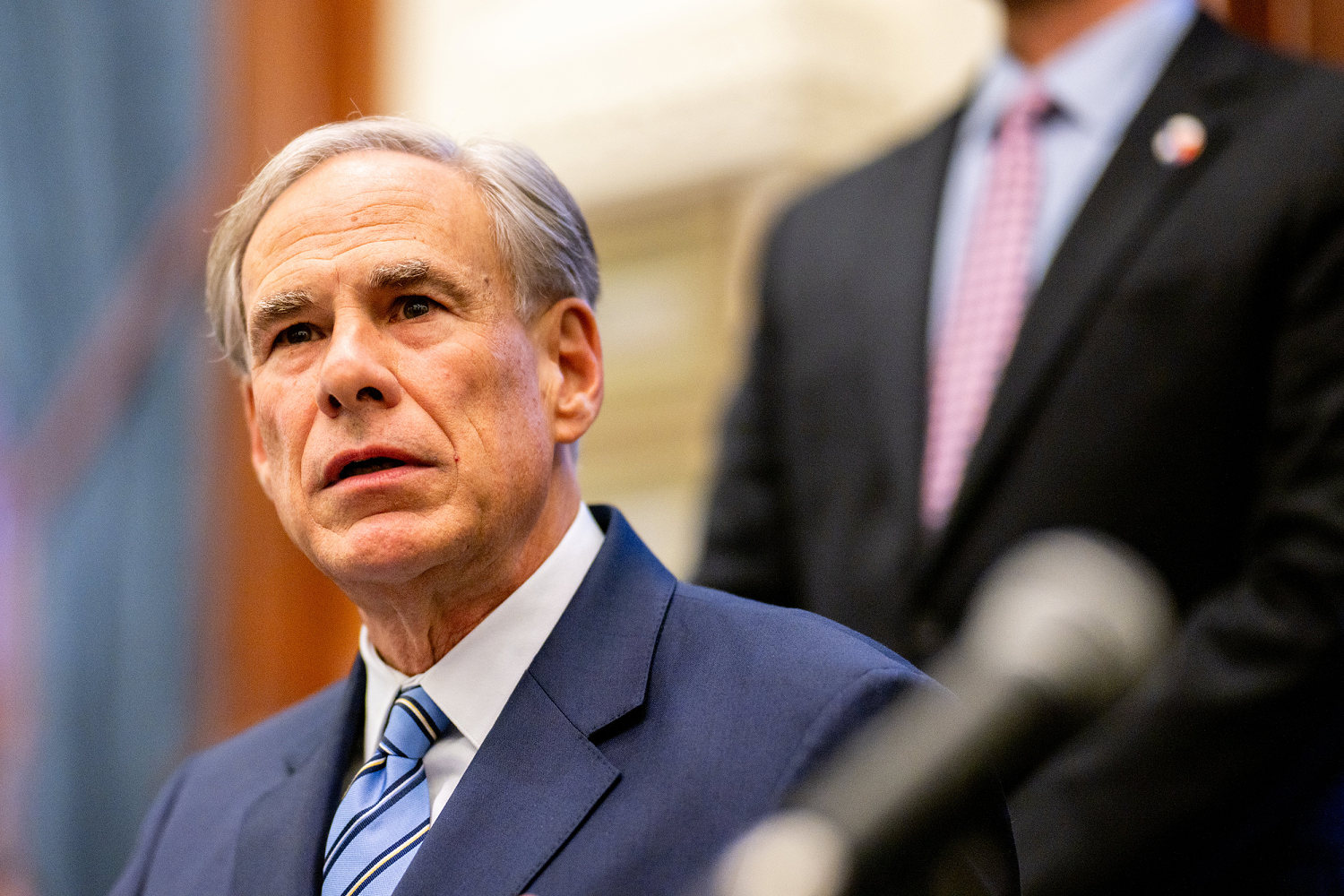
Texas Gov. Greg Abbott claims to be all about “America First,” so why is he threatening to punish a city in his state for insufficient loyalty to Israel?
The city council of San Marcos has set up a vote for next week on a largely symbolic resolution that calls for “an Immediate, Permanent, and Sustained Ceasefire in Occupied Palestine, Arms Embargo on the State of Israel, Recognition of Palestinian Sovereignty and Protection of Constitutional Rights.”
The proposed resolution reads in part:
We follow the lead of the World Health Organization, United Nations, Save the Children, Amnesty International, Human Rights Watch, His Holiness Pope Francis, more than 150 countries, and countless other organizations in the United States and around the world in calling for a ceasefire, because what happens internationally impacts our constituents locally. We believe in the shared humanity of all people, reiterate that all people are entitled to live life in safety and free from violence, and affirm these as common values held by San Marcos residents and leaders.
The resolution specifically highlights that Palestinians of Jewish, Muslim and Christian faiths are facing a humanitarian crisis in Gaza and says that the council “condemns anti-Palestinian, Islamophobic, antisemitic, and all xenophobic rhetoric and attacks.” Nonetheless, in a threatening letter to San Marcos’ mayor, Abbott decried the resolution for being “antisemitic.”
In the letterAbbott wrote that “anti-Israel policies are anti-Texas policies” and said the proposed resolution “seems calculated to violate” a state law on boycotting Israel. The resolution notes that San Marcos residents’ tax dollars funded more than $4 million of Israel’s weapons purchases in 2024 and says that San Marcos “stands to benefit from a reallocation of local funds towards essential domestic priorities such as transportation, education, housing, healthcare, environmental protection, and public goods and services, which currently face neglect due to state and federal appropriations to Israel’s military.”
According to Abbott, this puts the city’s state grants at risk. He concluded by saying:
Whenever San Marcos enters into grant agreements with my office, it is required to certify that it will comply with all state laws, including laws prohibiting government support for boycotts of Israel. My office is already reviewing active grants with San Marcos to determine whether the City has breached terms by falsely certifying compliance with Texas law. If the City Council adopts this Resolution, the Office of the Governor will not enter into any future grant agreements with the City and will act swiftly to terminate active grants for non-compliance. I will further direct all other state agencies to review agreements with the City for possible breach.
The hypocrisy at play is hard to ignore. Abbott has made a fairly similar argument to the one made in the proposed resolution, in which he says federal aid to Ukraine would be money better spent on Americans. For the record, most of the funding authorized for Ukraine has been spent making purchases from the U.S. defense industrybut the contradiction is clear: Abbott seems perfectly fine with the argument that American tax dollars are better off staying at home — unless anti-Israel sentiment is involved.
With a recent Pew Research survey showing that 53% of Americans carry an unfavorable view of Israelup from 42% in March 2022, it seems like Abbott is intent on quashing broadening dissent over all else.
The Dictatorship
The Lakers need to accept a cold, hard truth about LeBron James

Let’s start with a cold truth: LeBron James is (probably) not retiring.
Many will speculate about that possibility, having just watched a 40-year-old superstar end his 22nd NBA season on the losing end of a first-round “gentleman’s sweep” by the lower-seeded Minnesota Timberwolves. After one of the most decorated careers in NBA history, James gave us one of his most impressive seasons, putting up numbers at his age — 24.4 points, 7.8 rebounds and 8.2 assists — that most players would be happy to have in their 20s.
I’ll sit down with my family, my wife and my support group and have a conversation with myself on how long I want to continue to play.
LEBRON JAMES
When he was asked after Wednesday night’s 103-96 loss how much longer he’d play, James said, “I don’t know. I don’t have an answer to that. Something I’ll sit down with my family, my wife and my support group and kind of just talk through it and see what happens. And just have a conversation with myself on how long I want to continue to play.”
There’s nothing left for James — the 2004 rookie of the year, a four-time league MVP, four-time NBA Finals MVP, three-time All-Star MVP and the league’s all-time leading scorer — to prove in the NBA. But like most aging elite athletes of his era (see: Tom Brady, Alexander Ovechkin and Aaron Rodgers), he’s more likely to see his longevity as reason to come back and chase another ring rather than calling it a career.
That’s why the Lakers should be thinking about when they’ll move on from him instead of waiting for him to choose. The Lakers would probably never trade James, but they could make it clear that his time with the team has an expiration date. They should also be trying to figure out how and if they’ll be able to build a team around Luka Doncicthe 26-year-old superstar who essentially fell in their lap their season.
Many Lakers fans will loudly object to the idea of the Lakers moving on from James, especially given the remarkable numbers the league’s oldest active player put up this season. But those same fans are unlikely to tolerate a long dry spell between championships. Lakers Nation is among a small group of fanbases (Patriots, Steelers, Celtics, Yankees) who’ve raised so many banners that they believe winning championships is their right.
That means Lakers fans don’t have the tolerance for the kind of losing that usually accompanies a rebuild. The dilemma, of course, is that fans also don’t want their aging superstar to walk away, especially when he supplies enough thrilling plays and wins to give them hope that he’ll deliver another ring.
But if history is any guide, chances are low LeBron James will win the Lakers another title. Rare is the superstar athlete who goes out on top, and the Lakers organization and fans should be honest about that. Kobe Bryant won his fifth and final NBA championship in the 2009-2010 season at age 31. He played six more seasons, two of them shortened by injury, and put up big numbers. But he retired without another championship. The only title the Lakers have won since Bryant was during the pandemic-shortened 2019-2020 season, the first year that James and big man Anthony Davis played together. James was 35 then.
Chances are low LeBron James will win the Lakers another title.
To be clear, the Lakers committed themselves to dragging out the LeBron James era for as long as they can. Last offseason, they signed him to a two-year extension worth more than $101.3 million, with just over half of that due to him next season. If he makes it through next season healthy, few would be surprised if they re-signed him. They drafted his son and namesakenicknamed “Bronny,” who they hope will improve as a player with his dad still on the roster. Most significantly, the Lakers traded Davis to the Dallas Mavericks for Doncic, giving James a young offensive savant they hoped would help James make it out of the Western Conference and into his 11th NBA finals.
That didn’t go anywhere near according to plan. With the Lakers down 3-1 and playing for their season on Wednesday night, Doncic took a hard foullanded awkwardly and was hobbled by a bad back the rest of the game. He still contributed 28 points, 7 assists and 9 rebounds but for the time he spent on the floor, the Lakers scored five fewer points than the Timberwolves did.
Doncic is 14 years younger than James, but at times Wednesday he looked five years older. That made me wonder, “Where is this headed?” There was no indication that the back injury was serious or would affect Doncic’s play beyond his offseason rehab, but back injuries are tricky. If you buy that Dallas moved Doncic in part because of their concerns that he was poorly conditioned and didn’t maintain his health, it doesn’t take a big leap to be concerned about the lasting impact of an injury.
Hoop nerds have long debated whether Doncic’s immense talent will ever be validated with a championship. He didn’t win a championship in six full seasons in Dallas, and if he never does in L.A., such a failure might even flip negative public opinion about Mavs general manager Nico Harrison trading Doncic for Davis. (Though it’s impossible to forgive his claim that he didn’t know just how beloved Doncic was in Dallas.)
Doncic is 14 years younger than James, but at times Wednesday he looked five years older.
James’ success next year and beyond, if he wants to keep playing, is more tied to Doncic than any other player on the Lakers’ roster. Which brings us back to: What do the Lakers really expect, and how much longer will it be before they start thinking about a true rebuild?
Lakers fans might not realize it, but they may already be in another championship drought as they watch and hope their best player can make it happen one more time. James’ career has been singularly excellent but we all eventually have to learn how to move on, even from him.
Keith Reed is an award-winning journalist and a past senior editor at ESPN. His work has appeared in The Boston Globe, The Root, Vibe, Essence and elsewhere.
The Dictatorship
‘We won’t back down’: Resistance against Trump continues with hundreds of May Day protests
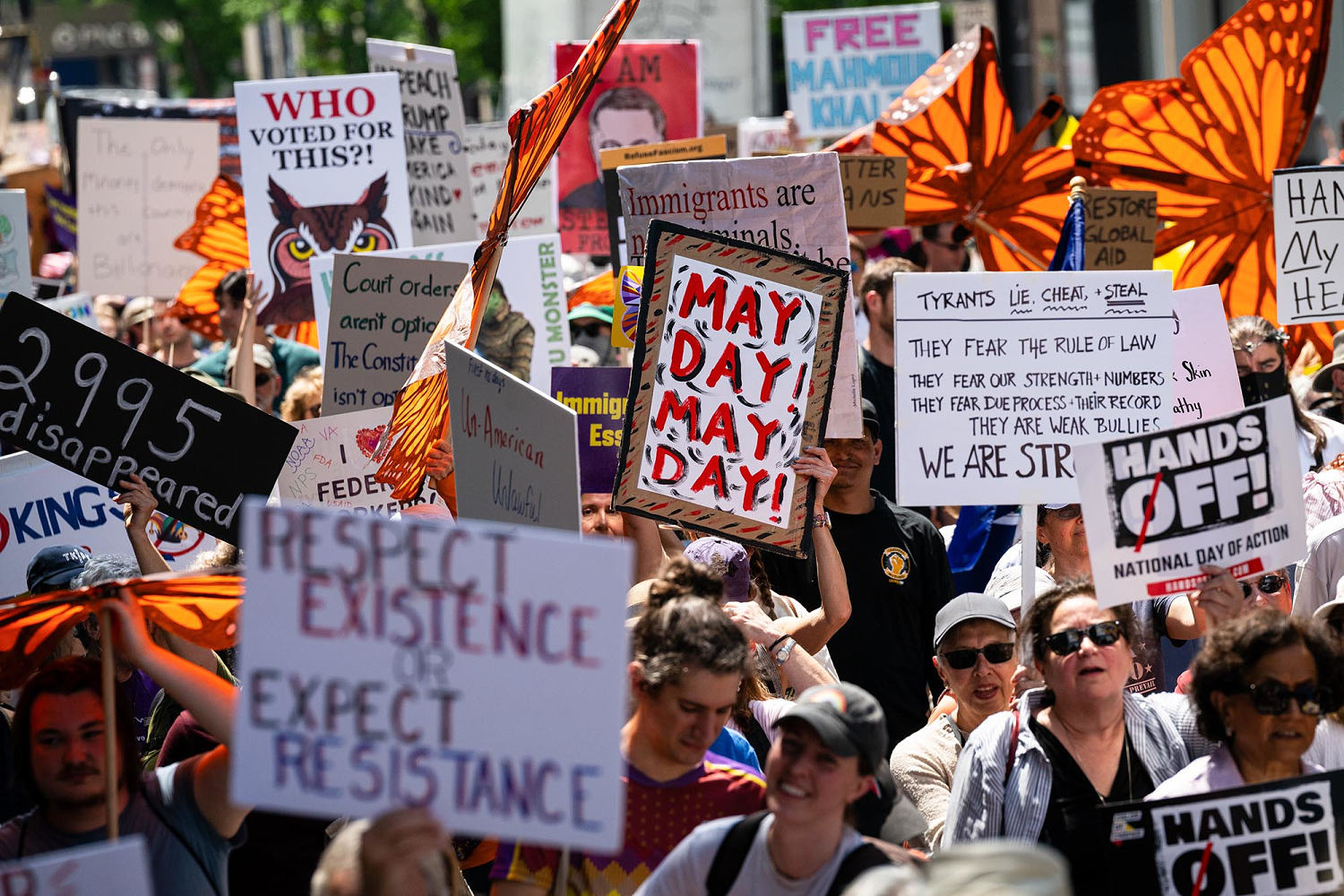
Every year on May 1, activists across the globe take to the streets to mark May Day, also called International Workers’ Day. In the U.S., this year’s protests have taken on new meaning, becoming yet another outlet for some Americans to voice their opposition to Donald Trump and what organizers call his administration’s “war on working people.”
We won’t back down—we will never stop fighting for our families and the rights and freedoms that propel opportunity and a better life for all Americans.
may day strong
Many of Thursday’s nationwide protests were organized by May Day Strong, a coalition of local groups, including labor unions, teachers associations, and national organizations such as MoveOn, Women’s March and the 50501 movement.
A statement on the group’s website accuses the Trump administration of “defunding our schools, privatizing public services, attacking unions, and targeting immigrant families with fear and violence.”
“Working people built this nation and we know how to take care of each other,” the statement continues. “We won’t back down—we will never stop fighting for our families and the rights and freedoms that propel opportunity and a better life for all Americans. Their time is up.”
Organizers said more than a thousand events are planned across the country for Thursday, including large-scale demonstrations in major cities such as Los Angeles, ChicagoNew York City and Washington, D.C. Sen. Bernie Sanders, who’s been crisscrossing the nation as part of his “Fighting Oligarchy” tour with Rep. Alexandria Ocasio-Cortez, is set to speak at an event in Philadelphia.
This year’s May Day comes as Trump’s top campaign donor, billionaire Elon Musk, continues to use the Department of Government Efficiency to gut the federal budget, leaving tens of thousands of federal workers without jobs. May Day Strong said part of its goal was to demand “a country that puts our families over their fortunes.”
Thursday’s protests aren’t the first major demonstrations against the president. In April, thousands participated in a series of “Hands Off” protests across the country, marking the largest single-day, nationwide display of resistance against the second Trump administration.
Along with the mass demonstrations, Trump continues to battle record-low approval ratings. According to an average of 16 independent national polls conducted over the last two weeks, Trump’s job approval rating stands at just 43%, placing him at the bottom of the list of modern presidents at this same point in their term.
-

 The Josh Fourrier Show6 months ago
The Josh Fourrier Show6 months agoDOOMSDAY: Trump won, now what?
-
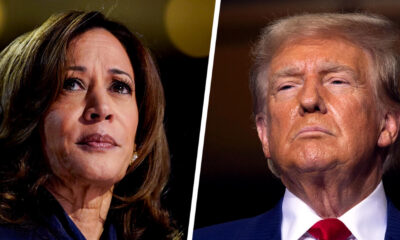
 Politics6 months ago
Politics6 months agoWhat 7 political experts will be watching at Tuesday’s debate
-
Uncategorized6 months ago
Bob Good to step down as Freedom Caucus chair this week
-
Economy6 months ago
Fed moves to protect weakening job market with bold rate cut
-
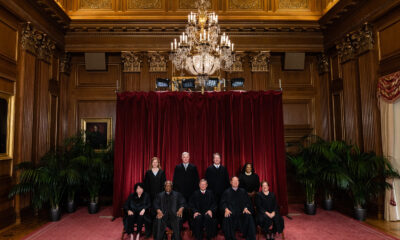
 Politics6 months ago
Politics6 months agoHow Republicans could foil Harris’ Supreme Court plans if she’s elected
-
Uncategorized6 months ago
Johnson plans to bring House GOP short-term spending measure to House floor Wednesday
-
Economy6 months ago
It’s still the economy: What TV ads tell us about each campaign’s closing message
-
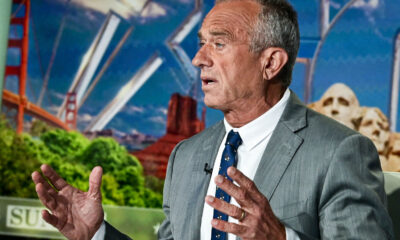
 Politics6 months ago
Politics6 months agoRFK Jr.’s bid to take himself off swing state ballots may scramble mail-in voting







